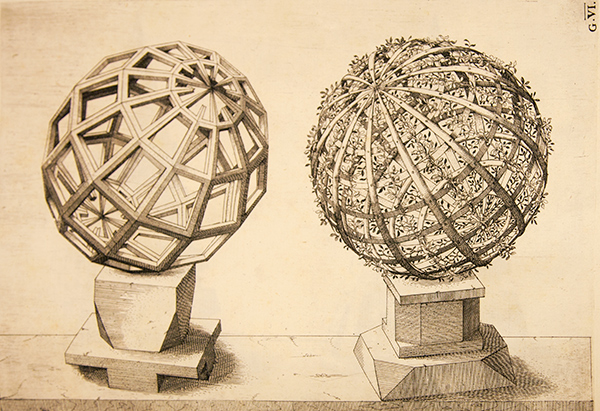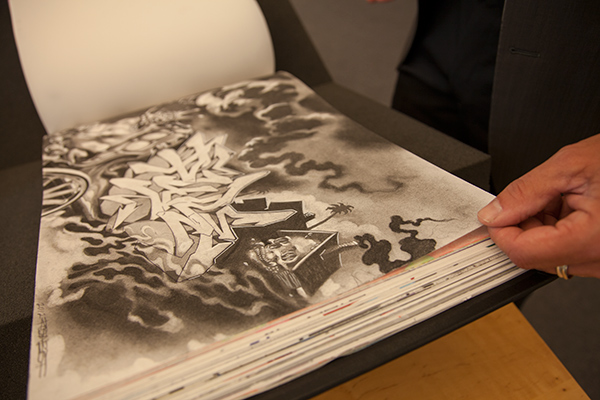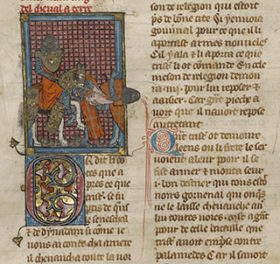
Me with the completed Getty Graffiti Black Book. LA Liber Amicorum, 2012. 143 leaves, bound in black leather, 32 x 50 cm. The Getty Research Institute, 3023-201. Gift of Ed and Brandy Sweeney
Throughout 2013, the Getty community participated in a rotation-curation experiment using the Getty Iris, Twitter, and Facebook. Each week a new staff member took the helm of our social media to chat with you directly and share a passion for a specific topic—from museum education to Renaissance art to web development. Getty Voices concluded in February 2014.—Ed.
The artists of graffiti craft letterforms, draft perspective, and merge line, color, and form with the same techniques employed by Renaissance masters like Albrecht Dürer. Now the work of graffiti and tattoo artists—just like those of Dürer—are part of the Getty’s rare-book collections via a monumental, 150-artist collaboration called LA Liber Amicorum, more popularly known as the Getty Graffiti Black Book. Page through the entire book here.
The project was the brainchild of local collector Ed Sweeney, who came to the Research Institute’s chief curator Marcia Reed and me with an unusual and ambitious idea. Ed had begun collecting graffiti art and become friends with several street artists, and had also had become intrigued with the blank sketchbooks that many graffiti artists carry with them, called black books (or “piece books”). They ask friends, crew members, or others whose work they simply admire, to “hit up” their books: in other words, fill a page with artwork, whether a simple drawing, freestyle lettering, or elaborate composition. What if, Ed asked, we brought together the work of such local artists into a large-scale version of those black books, a 21st-century compendium of the handstyles and tags of L.A. streetwriters? Were we interested in creating a Getty master-piece book?
Now, I grew up in Brooklyn, and was exposed to graffiti long before I ever saw a rare book, but I’ve always found an affinity between the two. Book history resonates with the echoes of glyphs and symbols that morph into writing as a visual form. “Graffito” is old Italian slang for a “little mark,” and in ancient Greek the verb graphein meant “scratch, draw, paint,” probably long before it came to mean “to write.” If you’ve ever doodled, you’ve experienced the innate human urge to graph, to make a mark. Graffiti art is about manifesting your mark on the world, whether others like it or not.

One of the first looks at some of the pages for the Getty Graffiti Black Book. We examined a few of our special collections volumes to compare illustrations.
So Ed, Marcia, and I started to invite local graffiti and tattoo artists—Angst, Axis, Big Sleeps, Chaz, Cre8, Defer, EyeOne, Fishe, Heaven, Hyde, Look, ManOne, and Prime (to name a few)—to visit the Research Institute and gauge their interest in helping us create a black book for the Getty. To help pique their interest, I pulled some rare books from the 1500s to 1700s out of the Research Institute vaults: ones that feature type designs, visual symbolism, and the like; ones I hoped might provoke some kind of artistic response.
Together we pored over Renaissance calligraphy manuals brimming with elaborate and quirky letterforms; emblem books rich in inventive symbolism expressly designed to make a mark on memory; examples of Arabic calligraphy, Baroque books claiming to decipher Peruvian Quipu knot-language, volumes of pseudo-scientific phonetics, exotic alphabets, and more. We also examined two visionary masterpieces that are among my favorites: Albrecht Dürer’s Introduction to Measurement, a demonstration of how the artistic imagination can transform line, circle, and S-curve into complex illusions of three-dimensionality on a two-dimensional plane; and Wenzel Jamnitzer’s Perspective of Regular Bodies, which riffs on the concept of the so-called Platonic solids with engraved illustrations that progress from the imagined atomic shapes of the elemental particles of fire, air, earth, and water to almost surrealist mindscapes of complex, imaginary geometric molecules.

Engraving from Wenzel Jamnitzer’s Perspective of Regular Bodies (Perspectiva corporum regularium), 1568. The Getty Research Institute, 2578-543
The artists’ bond with the books was immediate and visceral; they intuitively recognized the connections to their own artistic practice. But the book that exerted the most powerful pull was a 17th-century liber amicorum (Latin for “book of friends”), an elaborate form of autograph book that became a fad among university students, aristocrats, and academics starting in the mid-1500s. Like today’s yearbooks, a liber amicorum would be passed from hand to hand to be filled with images and texts as mementos for the owner—a black book from four centuries ago.
Inspired by this meeting of minds across the centuries, this core group of artists became both creators and curators, crafting pages for the black-book-to-be and distributing paper to 10 to 15 members of their own crews to fill however they wanted. Some of the artists were from rival tagging crews and weren’t willing to be in the same room together; they were willing, however, to have their work bound together into the Getty Graffiti Black Book.

An early look at pieces from the Getty Graffiti Black Book next to rare books from the Research Institute’s special collections
The book is arranged alphabetically, its pages segregated only by archival tissue guard. Contributing artists range from newly minted grads of Sci-Arc and CalArts, to prominent tattoo artists, to former gang members. One artist’s work was donated posthumously by his mother; another was sent from prison; still another was created with assistive technology to help the artist cope with degenerative illness.
The 143 pieces by over 150 contributors likewise represent a phenomenal range of media. Some artists wielded graphite or black pen to create letterforms and abstractions, while others saturated their sheets with intense color and detail, creating miniature murals. Some subtracted from their pages through cutouts; others added with stickers, board, fold-outs, or relief pigment.
The completed black book, officially named LA Liber Amicorum, is exquisite. More important, the volume simply works. It is informed by the past, but speaks of Los Angeles now, with a creative voice suffused with the city’s light, darkness, landscape, and talent. It is a book of former rivals bound together by the common urge to combine their artistic marks into an LA book of friends.

LA Liber Amicorum (detail), 2012. 143 leaves, bound in black leather, 32 x 50 cm. The Getty Research Institute, 3023-201. Gift of Ed and Brandy Sweeney
Page through the entire Black Book here.
Thank you to the artists of LA Liber Amicorum:
Acme, Adict One, AiseBorn, Angst, Arbe, Asylm, Augor, Axis, Bash, Betoe, Big Sleeps, Blosm and Petal, Bob Roberts (Bad Bob the Worst), Cab, Cache, Cale One, Care, Charlie Roberts, Chaz, Chris, Chubbs, Crae & K4P Crew, Craola, Craze, Cre8, Crime (Rick One), Cryptik, Czer One, Defer, Demer One, Design9, Dr. Eye, Duem and Crae, Dye5, Earn One, Eder, Elika, Else, Enk One, ESK31, Estevan Oriol, Eye One, Fearo, Fishe, Gabe88, Gasoline, Gkae, Graff One, Green, Gorgs, Haste, Heaven, Hex (LOD), Hex (TGO), Hyde, Jack, Jack Rudy (Mr. Huero), Jake One, Jero and Each, Joker One, Junior (“Kost One”), K4P (Pranxs, Method, Biser, Crae, Dsrup), K4P (Chelo, Noek, Notik), Kaos, Kasl, Keo One and Wram One, Kofie, Kopyeson, Kozem, Krenz (Yem), Krush, Kwite One, Kyle Kyote, Ler Keen, Look, Mach Five, Mandoe, Man One, Mark7, Mike Miller, Miner, Mister Cartoon, NicNak, OG Abel, Owen, Panic One, Patrick Martinez, P.Chuck, The Phantom, Phever, P. Jay One, Playboy Eddie, Plek One, Pletk P17, Precise, Prime, Punk, Push, Pyre One, Pyro, Rayo, Relic, Relm, Retna, Rev, Rich One, Rick Ordoñez, Risk, Rival, Roder 169, Saber, Sacred 194, Sel, Ser, Shandu One, Sherm, Siner, Skan One, Skez, Skill, Slick, SomeOne, Soon One, Spade, Spurn, Swank, Syte One, Teler, Tempt, Test, Thanks One, Thel, The Phantom, Trigz, Tyke Witnes, Useck, Versus 269, Vox One, Vyal, Werc, Wise, Wisk, Woier, Zes




Ok sweeet! Now the next idea is to scale it down and mass produce it so that I can buy one for my book shelf! Please and Thank You. I’ll expect my free copy in the mail ahhahah!